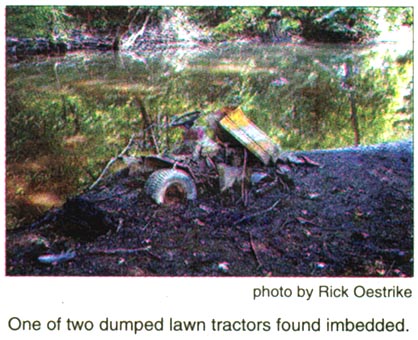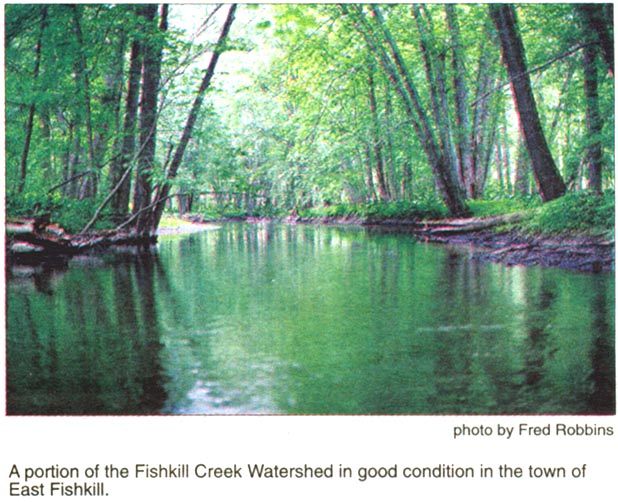For the Poughkeepsie Journal
Environmentalists shouldn't be the only ones concerned about the Fishkill Creek Watershed. The condition of the watershed can have far-reaching affects that [impact] wildlife, the quality of drinking water, and the average homeowner's property value.


The Fishkill Creek Watershed encompasses approximately 194 square miles. It is a network of streams, creeks, and wetlands interconnected with groundwater. It begins in Union Vale and flows through parts of LaGrange, Wappingers Falls, Wappinger, Beekman, East Fishkill, Beacon, and parts of Putnam County. The system converges and empties into the Hudson River. Many private and public groundwater wells rely on water drawn from the sand and gravel aquifer of the Clove Creek and Fishkill Creek valleys of the watershed.
"There are good self-interest reasons for people to protect the watershed," said Fishkill Creek Watershed Committee Chairman Rick Oestrike. "Because everything is connected, a problem in one area affects everyone else downstream. It is important to think of the issues on a watershed level, not just what's happening in your own backyard where you can see." He added that people that live along Sprout Creek, Jackson Creek, Whaley Lake Brook, and Clove Creek may not even be aware they are living near the watershed and its inherent importance.
The Fishkill Creek Watershed Committee is a non-advocacy group, its mission is to encourage individuals and public and private groups to work for its protection. The committee was formed by concerned citizens and members of the Dutchess County Environmental Management Council (EMC).
In May and August 2004, volunteers and members of the watershed committee participated in the Fishkill Creek Streamwalk Program designed by the Lower Hudson Coalition of Conservation Districts. The program studied 16 miles broken up into segments of the main stem of the Fishkill Creek. The streamwalk participants took notes and made observations that identified 55 impaired sites. They took more than 700 digital photos, and took GPS coordinates of important sites including bridges, dams, outlet pipes, and areas of erosion. None of the segments studied received an excellent rating. Seven were scored good, four received an assessment of fair, and five were considered in poor condition.
The streamwalk also identified impairments including: diminished vegetation growth along streams, litter, discharge pipes, dams that have changed the flow of streams, excess sedimentation, excess algae, and unnatural high water temperatures.
Oestrike said that residents living near the watershed should be concerned. Pollution in the watershed can contaminate groundwater and negatively affect people's health. He said that aesthetics are another concern. He said that people move to an area because of its beauty. If the watershed is polluted, it undermines the quality of life and scenic beauty. "Property values also depend on water quality," he said.
"There are also environmental concerns for animals and plants. They have to live there. If we damage the watershed, they might not be able to live there and survive."
In 2005, the committee would like to remedy the problems that were identified in the watershed. They would like to clean up litter that is present in the watershed and remove some of the small dams that adversely affect the stream flow. Regarding education, the committee also would like to introduce environmental curriculum to area schools that it has been developing. They will also continue public outreach through talks and the media.
The committee also looks forward, along with the EMC, to establishing a Master Plan for the watershed once a preliminary plan is developed. Oestrike said that the towns connected to the watershed have to sign off on any plans before they can move forward.
The committee recommends that residents keep the watershed healthy by never disposing of automotive fluids and solvents into its waters. They suggest that people dispose of fluids at a hazardous waste collection facility or contact the Dutchess County Resource Recovery Agency. You can also contact your town about collection dates of hazardous materials.
To further avoid activity that is detrimental to the watershed, the committee recommends that people avoid hosing down paved surfaces, using "dry clean" methods to clean automobile spills, practice stream-safe swimming pool and spa techniques by never draining pool and spa water into the street or storm drains. You can also help by making sure that gutters and drains do not carry water to streams, by removing trash from creeks and streams, and by properly maintaining underground tanks and septic systems.
The Fishkill Creek Watershed Committee meets the first Monday of the month at the East Fishkill Library from 7 to 9 p.m. For additional information view the Web site: [FishkillCreekWatershed.org].
